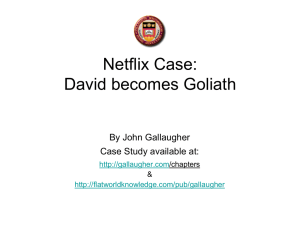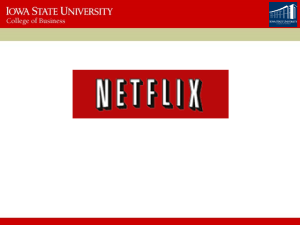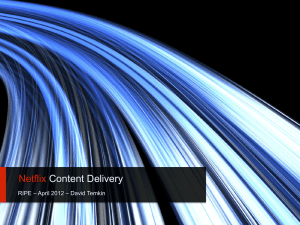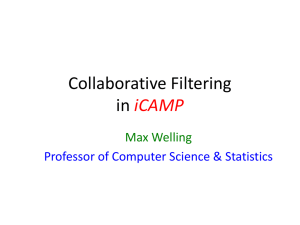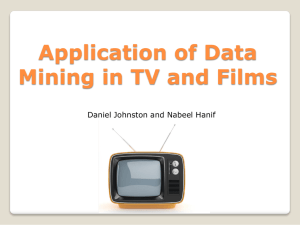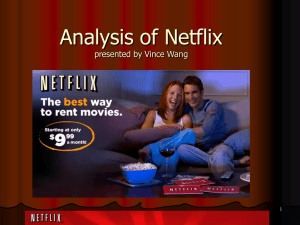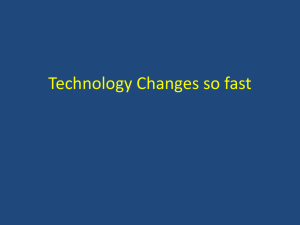Netflix in Two Acts: The Making of an E
advertisement
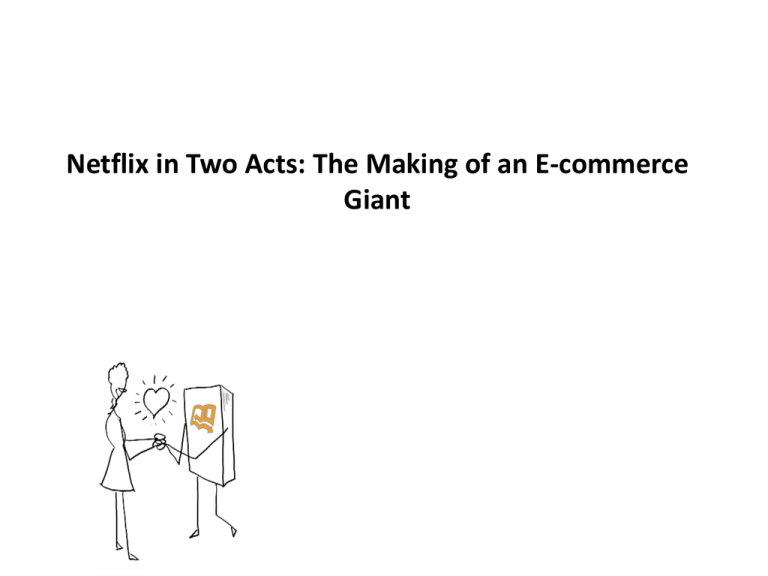
Netflix in Two Acts: The Making of an E-commerce Giant 4-1 Learning Objectives • Understand the basics of the Netflix business model • Recognize the downside the firm may have experienced from an early IPO • Appreciate why other firms found Netflix’s market attractive, and why many analysts incorrectly suspected Netflix was doomed 4-2 Learning Objectives • Understand how many firms have confused brand and advertising, why branding is particularly important for online firms, and the factors behind Netflix’s exceptional brand strength • Understand the “long tail” concept, and how it relates to Netflix’s ability to offer the customer a huge (the industry’s largest) selection of movies • Know what collaborative filtering is, how Netflix uses collaborative filtering software to match movie titles with the customer’s taste, and in what ways this software helps Netflix garner a sustainable competitive advantage 4-3 Learning Objectives • List and discuss the several technologies Netflix uses in its operations to reduce costs and deliver customer satisfaction and enhance brand value • Understand the role that scale economies play in Netflix’s strategies, and how these scale economies pose an entry barrier to potential competitors • Understand the role that market entry timing has played in the firm’s success 4-4 Learning Objectives • Understand the shift from atoms to bits, and how this is impacting a wide range of industries • Recognize the various key issues holding back streaming video models • Know the methods that Netflix is using to attempt to counteract these challenges 4-5 Introduction • When Netflix went public, financial disclosure rules forced the firm to reveal how profitable it was • Rivals such as Blockbuster and Wal-Mart showed up • Competitors underestimated Netflix because: – It was an Internet pure play without a storefront – Its overall customer base was microscopic in comparison 4-6 Introduction • Newcomers mimicked Netflix with cheaper rival efforts forcing Netflix to cut prices • Netflix survived big competitors, a price war, and spending on the rise 4-7 Why Study Netflix? • It gives us a chance to examine how technology helps firms craft and reinforce a competitive advantage 4-8 How Netflix Works • Netflix settled on a DVD-by-mail service model – It charges a flat-rate monthly subscription – Customers don’t pay mailing expenses and late fees • Videos arrive in Mylar envelopes containing: – Prepaid postage – Return address • After watching the video, consumers: – Slip the DVD back into the envelope – Drop the disc in the mail 4-9 How Netflix Works • Users make their video choices in their “request queue” at Netflix.com • Consumers use the Web site to: – – – – – Rate videos Specify movie preferences Get video recommendations Check out DVD details Share their viewing habits and review 4-10 Tech and Timing: Creating Killer Assets • Building a great brand online starts with offering exceptional value • Advertising builds awareness, but brands are built through customer experience • Subscribers expectations from Netflix: – – – – – Huge selection Ability to find what they want Timely arrival Ease of use and convenience Fair price Technology drives all of these capabilities Technology is at the center of the firm’s brand building efforts 4-11 Selection: The Long Tail in Action • Netflix offers its customers a selection of over 100,000 DVD titles • Traditional retailers cannot offer this because of shelf space constraints • Traditional retailers can determine their breakeven point by considering: – – – – – Number of customers that can reach a location Store size Store inventory Payback from inventory Cost to own and operate the store 4-12 Selection: The Long Tail in Action • Internet firms can have just a few highly automated warehouses • Long tail: A phenomenon whereby firms can make money by offering a near-limitless selection 4-13 Figure 4.2 - The Long Tail 4-14 Selection: The Long Tail in Action • The long tail works because: – Cost of production and distribution drop – It gives the firm a selection advantage that traditional stores cannot match – Geographic constraints go away and untapped markets open up 4-15 Selection: The Long Tail in Action • Netflix has used the long tail to create close ties with film studios – Studios earn a percentage of the subscription revenue – Netflix gets DVDs at a very low cost – Studios do not spend on additional marketing 4-16 Cinematch: Technology Creates a Data Asset that Delivers Profits • Netflix uses a proprietary recommendation system called Cinematch • Each time a DVD is returned, Cinematch asks the customer to rate it • Collaborative filtering: A classification of software that monitors trends among customers and uses this data to personalize an individual customer’s experience – It can be mimicked by competitors 4-17 Cinematch: Technology Creates a Data Asset that Delivers Profits • The data provided by Cinematch is a switching cost • To see how strong switching costs are is to examine Netflix’s churn rate – Churn rate: The rate at which customers leave a product or service – In mid-2008, churn rates for Netflix’s most active regions were below 3 percent • Netflix’s marketing costs benefit from satisfied customers, as referrals are a better choice than advertisements • Netflix launched a crowdsourcing effort known as The Netflix Prize 4-18 A Look at Operations • Technology lies at the heart of Netflix’s warehouse operations – Netflix has a network of fifty-eight ultra high-tech distribution centers – Distribution centers are all located close to U.S.P.S. facilities – Trucks collect DVD shipments from these U.S.P.S. hubs and return the DVDs to the nearest Netflix center – Scanners pick out incoming titles – Netflix presorts outgoing mail before dropping it off at U.S.P.S. facilities – All DVDs are hand-inspected for cracks and smudges – Warehouse processes are linked to Cinematch 4-19 A Look at Operations • Staff members are expected to focus on improving the firm’s processes • Quality management features are built into systems • Netflix can monitor and record the circumstances surrounding any failures 4-20 Killer Asset Recap: Understanding Scale • Netflix’s size gives it a huge scale advantage • Scale economies allow firms to: – Lower prices – Spend more on customer acquisition, new features, or other efforts • Smaller rivals have an uphill fight • Established firms end up straddling markets 4-21 Killer Asset Recap: Understanding Scale • By moving first, Netflix gained scale advantages – Largest network of distribution centers – Largest customer base – The firm’s industry-leading strength in brand and data assets 4-22 Act II: Netflix and the Shift from Mailing Atoms to Streaming Bits • Many media products are created as bits (digital files) • When we buy a CD, DVD, book or newspaper, we’re buying physical atoms that are a container for the bits 4-23 Access to Content • When Netflix launched its streaming video option, only 17,000 videos were offered • Legal issues involved in securing the digital distribution rights • Windowing restricts the number of titles available • Wal-Mart uses its bargaining power to encourage studios to: – Hold content from competing windows – Limit offering titles at competitive pricing during the new release period 4-24 But how does it get to the TV? • Netflix initially developed a prototype set top box • It then developed a software platform that allowed firms to build Netflix access into their devices • Advantages of the atoms to bits model – Netflix will eliminate a huge chunk of its shipping and handling costs – Bandwidth costs are minimal 4-25 But how does it get to the TV? • Disadvantages of the atoms to bits model – Wrangling licensing costs is a challenge – The switch to Blu-ray DVDs means that Netflix will be forced to carry two sets of video inventory • Standard • High-definition 4-26
